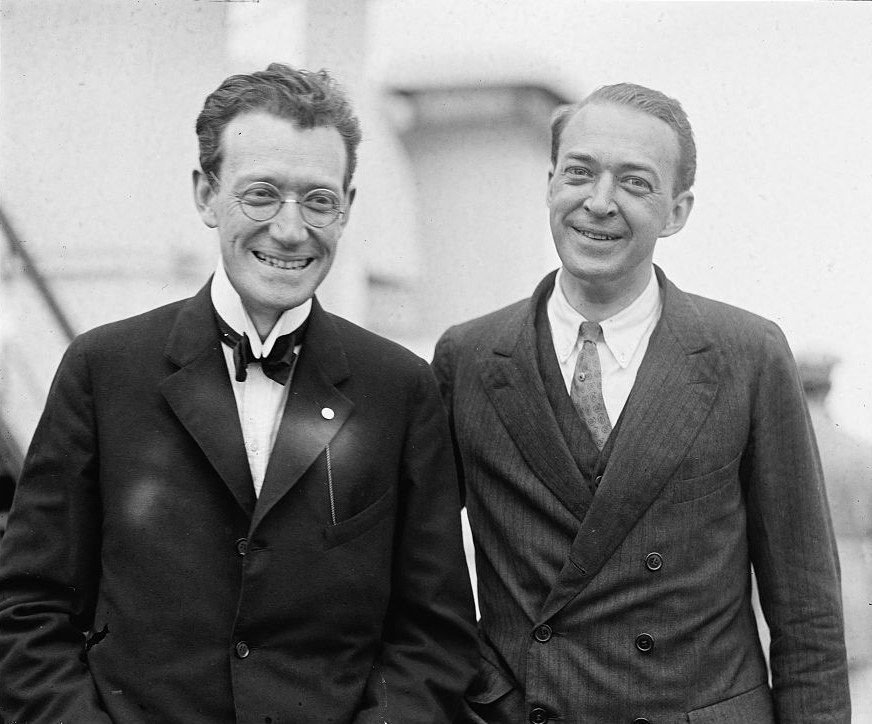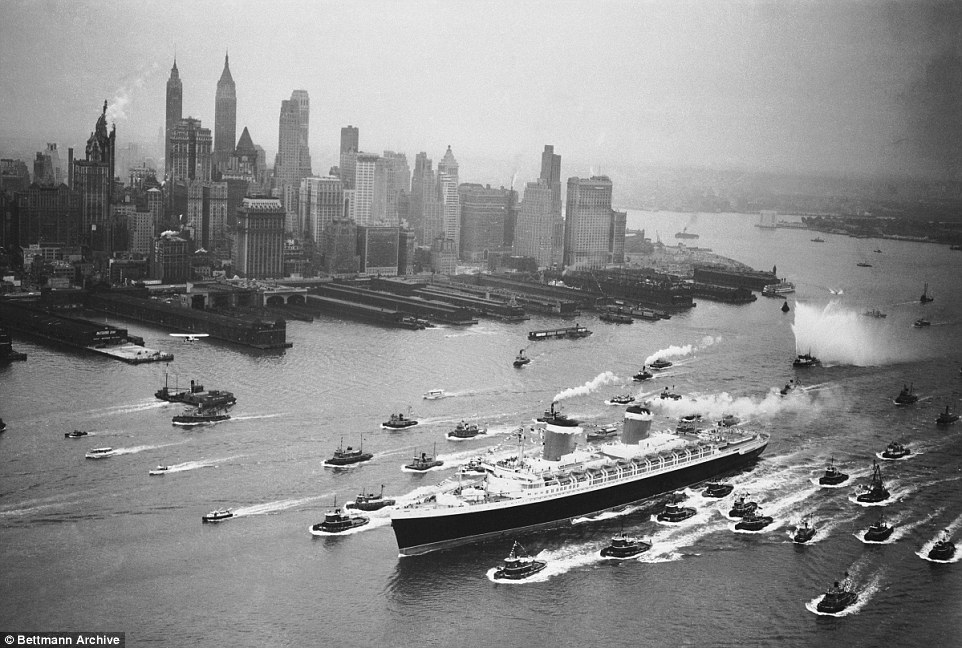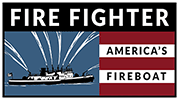The Man behind the Legend
At the start of 1937 the City of New York Fire Department was operating a a fleet of nine fireboats to protect what was at the time an expansive working harbor ringed on all edges by cargo piers, bulk goods terminals, and shipyards instead of parks and high-priced condominiums. Though the FDNY fleet was more than capable of handling any peacetime fire, the rapidly deteriorating political climate in Europe and likelihood that New York would once again be a major wartime supply port highlighted the need for a modern and more powerful fireboat to protect the city and its harbor. Before the city could even put together an official request for design proposals, a Marine Architect named William Francis Gibbs was knocking on the door of Mayor Fiorello LaGuardia with the blueprints of an ambitious fireboat design tucked under his arm.
Born on August 24th, 1886 in Philadelphia, PA, Gibbs showed a keen interest in ships from a young age and was known to have a voracious interest in vessel schematics and design theory. Accepted to Harvard University to study engineering, Gibbs spent most of his free time mock-designing new classes of Battleships and pursuing study in marine architecture rather than his assigned curriculum, leading to his departure from the school without a degree. Attending Columbia Law School from 1911-1913 at his fathers insistence, he practiced law for several years before he and his brother Frederic joined the International Mercantile Marine Company in 1915. Though neither brother had formal training as marine architects, both were soon at the forefront of their long-desired effort to build a pair of 1,000ft long ocean liners with unmatched power and speed, plans which were soon being backed for development by the likes of both the US Navy and J.P. Morgan. Though these plans never came to fruition, the brothers had cemented their reputation as skilled and ambitious designers, as well as sewn the seeds for later groundbreaking designs.

William (left) and Francis Gibbs aboard the SS Leviathan on its maiden voyage in June 1923. The brothers had completely redesigned the former German vessel inside and out for American trans-Atlantic service.
Promoted to Chief of Construction in 1919, Gibbs and his brother soon struck out on their own and founded Gibbs Brothers, Inc. and quickly amassed a reputation of creating and refitting vessels with unparalleled attention to detail, far-thinking designs, fastidious consideration of safety and fireproofing, tremendous power, speed and appealing aesthetics. Finding ample work through the 1920’s and into the 1930’s with Matson Lines and Grace Lines with designs for ocean liners and cargo liners, the firm added renowned architect Daniel H. Cox in 1929 and moved to offices in downtown New York City as Gibbs & Cox shortly thereafter, with W.F. Gibbs as lead architect.
As the world moved inexorably towards the Second World War, Gibbs was busy working to refine compartmentalization methods, redundant safety systems and fire protection designs which would go on to form the basis for the firms vessel submissions to the US Navy, War Shipping Board and Maritime Administration when the United States began to build up its naval and merchant marine fleets. Due in large part to Gibbs foresight and the proven soundness of his designs, Gibbs & Cox would become the primary ship design firm for the United States Government during the Second World War, producing brand-new designs for Cruisers, Destroyers, LST’s, Minesweepers, Tankers and the ubiquitous Liberty Ship. The firm also served as lead designer on a wide variety of ship conversions for wartime use, including a number of its own vessels. By war’s end, Gibbs & Cox-designed vessels accounted for some 63% of all merchant ships over 2,000 tons and 74% of all US Navy vessels built during the conflict, making William Francis Gibbs one of the greatest individual contributors to the American war effort.
After the war Gibbs returned his sights to the design of an ocean liner of unparalleled size, power, speed and luxury, and found an odd partner in the US Navy, which in the post-war/Cold War environment was eager to have access to a state-of-the-art troopship to move men and material across the ocean at high speed if required. Essentially given a blank check to design his dream vessel, Gibbs and his brother began five nonstop years of design and evaluation work on what would become the SS United States, the worlds greatest ocean liner. Constructed over a period of two years at Newport News, the United States was built to US Navy standards for combat survivability and with Gibbs exacting attention to fire suppression and containment. Equipped with four steam turbines producing 280,000hp to four screws, measuring 990ft long and making extensive use of aluminum in her upper decks to both reduce the risk of fire and reduce weight, the United States entered service in July 1952 and promptly captured the East & Westbound Blue Riband with speeds measured at 35.59 and 34.51 knots respectively, both of which still stand as the fastest crossing times for a regularly-scheduled passenger ship.

Fire Fighter provides a water cannon salute to the United States as she enters New York Harbor on her delivery voyage.
With the ship he had long envisioned now a reality and in regular operation, Gibbs would spend the rest of his years calling the Captain and Chief Engineer of his “big ship” as he called her to get daily at-sea updates on her operation, and he would personally attend every arrival and departure of the United States from New York City. It was a love affair that would last the rest of his days, during which he remained “at the helm” of Gibbs & Cox and continuing to guide the firms design process and ethos through his death in 1967.
But before we close this chapter on Fire Fighters’ famous architect, we’d better get back to that bundle of blueprints he brought to Fiorello LaGuardia and what made a man so enamored with large, powerful ocean liners devote so much of his time to a humble harbor fireboat. One of the lesser-known facts about William Francis Gibbs was that in addition to his interest in vessel design and architecture, he was keenly interested in fire fighting apparatus. While not busy crafting intricate levels of fire containment, suppression and prevention into his vessel designs to reduce the risk of fire at sea, Gibbs’ was often exploring ways to design and build more powerful and efficient firefighting gear to combat the fires that did break out.
Beginning in the early 1930’s, Gibbs started toying with an idea of building a super-powered fireboat for service on the water while simultaneously building a land-based counterpart which could travel beyond the shoreline while still bringing the capabilities of the harbor vessel to bear. Unfortunately, the technology available at the time and the forecast cost of the unit precluded the land-based variant being built for nearly thirty years, so Gibbs continued his tinkering on the water-based version until word reached his ears that the City of New York may be looking to purchase a new fireboat. Seizing the opportunity to combine two of his interests, Gibbs set about drafting the design of a one-of-a-kind fireboat which would be fitted with the most up to date, powerful and capable equipment available at the time.
The resulting blueprints were presented to Mayor LaGuardia, who eagerly accepted the design and put the wheels in motion to approve the staggering $1 Million price tag that came with such a state-of-the-art vessel. The need for employment in the waning years of the Great Depression, the looming conflict in Europe and the strong will of a pair of New Yorkers got the job done, and Fire Fighter would soon be off the drawing board and under construction as Hull #856 at United Shipyards at Mariners Harbor, Staten Island.



